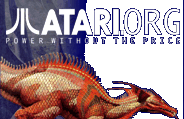| Subject: RE: Ideas on new Atari |
Author: earx (alinga.sron.nl)
Date: 03-14-2005 12:05
mint does have mmu support, but indeed, to me it doesn't seem that good.. although i haven't used it alot either.. the problem is that most atari programs still don't respect memory protection, so that it's more of a burdon than an advantage. at least i think so, but then again i don't have too much experience with mint's memprot.
GEM is surely an awful thing to program.. i've tried it, and with a lot of patience you can achieve a nice windowed GUI, but it's painful. you need to build loads on top of AES even upto the point of extending resource objects with some pixels for their 3d look. ARGH ;) if someone had extended AES to a application programmer friendly environment (wdialog.prg does this a bit) and this idea would have cought on (everyone would have it installed) then it wouldn't be bad to code GEM stuff.. but it just isn't the case.. this is also why a new graphical layer like DOpE is so welcome. it's a million times easier to program as AES, and even a lot easier than coding the Windows/Linux GUI's.
it's true on atari you can just set an interrupt (and at the same time trash another program ;)) but of course it's a great freedom and it helps to guarantee real-time behaviour (and nice for demos and games ;)). i write linux device drivers for a while (even hard real-time ones) and i can say it's not -that- difficult. the pci kernel interface does a lot for the device driver programmer.
about pegasos and other 'clone' systems with their own operating systems.. it's okay that they have emulation to enable usage of old software. of course, the drivers are still another issue. i agree with that.
about DOpE: it's just the graphical layer on top of the DROPS system. DOpE is unfinished, but once you have done some programming in it (like Tcl/TK, but even simpler), it seems really amazing. what is so great about this new OS is that it's possible to sandbox applications, aggegrate parts of applications' GUI and even inherit them (!)
of course the real-time stuff is cool too, although RTAI/RTLinux can do same it seems (graphics support is still a tough issue here).
the ACP will have some form of 'emulated' Mint, although I'm not up-to-date with Norman's current progress on that. anyway, offering both Mint and the native OS is a good one I think. i don't ask for more than that..
about your comments on the use of an MMU.. apps -always- have bugs. either accept it or you live in your own little world. what about apps accidentally writing in system memory? how stable will your system be after that? an MMU is required -especially- for memory protection! virtual memory comes in second, especially today.
my conclusion is that i really love the ACP to be:
- the hardware: no fans or anything, i love this. also it's similar to programming the old TOS series
- the OS: backward compatibility by running some form of Mint plus new OS with unprecedented capabilities
- the software: i'd -love- to code on it. i've been waiting for a machine like this ever since the phenix project got cancelled. would be great to make VLM programs, mpeg audio/video decoders, and sequencers for it :)) all with guaranteed frame rate, no cracks in the audio, etc =)
- as a whole: i think it's more attractive than any current options including a massively extended falcon: you need to place it in a custom tower (expensive and tedious) and buy components one-at-a-time. and of course it's a lot more powerful. an all-in-one solution is what we need! =)
|



